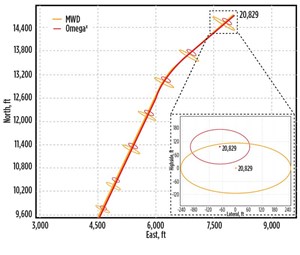Solid-state drop gyro system reduces ellipse of uncertainty, eliminates rig time offshore
Wellbore placement has been a topic of discussion for many years, but its relevance has increased significantly in the past decade. Operators have reduced the total number of days necessary to drill a well by an enormous margin, through the implementation of new technology and focusing on speed as the defining performance metric when drilling. The consequence of this philosophy is that the quality of the wellbore often suffers, in turn impacting the completion and production cycle, and thus the project’s overall profitability.
By reducing the risk of a well deviating from the planned objectives and actual trajectory, operators reap the benefits of placing the well within the hydrocarbon-rich target zone of the reservoir. With companies rethinking how they use their limited capital resources, precise, accurate wellbore placement is replacing speed as the primary value driver when drilling a well.

ADVANCED SURVEYING SYSTEM
In response to the industry’s demand for better wellbore placement, Gyrodata introduced the OmegaX drop gyro surveying system, Fig. 1. Powered by the company’s new solid-state gyroscopic technology, SPEAR, OmegaX is an all-attitude, solid-state drop gyro system that incorporates two independent three-axis sensor probes. The system’s sensor package measures the earth’s rotational rate, precisely and accurately determining inclination and true north. The OmegaX system is both much smaller and much more rugged than earlier gyroscopic systems, enabling its use in applications with temperatures up to 302° F while allowing greater flexibility in BHA design and configuration. The new system also eliminates the need for post-run calibrations, as it is not affected by mass unbalance errors, and can collect surveys during pipe connections, which reduces the typical rig time necessary to run a wireline gyro survey.
OPERATOR BENEFITS
The OmegaX system is helping companies operating offshore achieve their wellbore placement goals. In a recent project in the North Sea, an operator drilling an extended lateral section from a platform decided to run a gyro survey after reaching TD at 20,829 ft. The goal of the survey was to verify the accuracy of the initial MWD data and reduce the ellipse of uncertainty—that is, the possible volume in which the well could be located. Though the operator originally proposed a continuous wireline gyro survey, it ultimately chose the OmegaX system after reviewing the project with Gyrodata’s technical support team.

For this particular well, the OmegaX system reduced the ellipse of uncertainty by 56%, compared to the wireline continuous survey, Fig. 2. Compared to the MWD data—corrected for in-field referencing, multi-station analysis, and BHA sag—the OmegaX system provided a 46% reduction in lateral uncertainty. Even though there was no evidence of gross error on the MWD survey, the final wellbore position changed approximately 65 ft laterally. By running a drop gyro surveying system, the operator eliminated the HSE risks and saved the survey time that would have been necessary with an equivalent wireline run. Including time necessary for rig-up and rig-down, these savings were estimated at approximately 12 hr.
OTHER APPLICATIONS
The OmegaX system also has been used in the Gulf of Mexico, in several offshore projects, to improve survey accuracy and wellbore positioning. In addition, the solid-state technology eliminates the time necessary to send the tool for post-roll testing and survey validation, as required by conventional gyros. Ultimately, as operators continue to search for new technology innovations and ways to improve their bottom lines, they will need to seriously consider the criticality of accurate wellbore placement. Running a solid-state gyro is a proven method for achieving this goal.
- Driving MPD adoption with performance-enhancing technologies (January 2024)
- Rig electrification drives down emissions, bolsters efficiency while improving onshore drilling economics (October 2023)
- Wellbore seal control and monitoring enhance deepwater MPD operations (October 2023)
- Advancing casing drilling to deepwater: Rethinking top hole well construction (August 2023)
- Mobile electric microgrids address power demands of high-intensity fracing (July 2023)
- Utilizing electronic data captured at the bit improves PDC design and drilling performance (July 2023)


